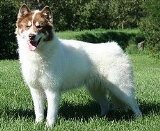
Canadian Eskimo Dog
Encyclopedia
The Canadian Eskimo Dog is an Arctic
breed
of dog
(Canis lupus familiaris), which is often considered to be North America
’s oldest and rarest
remaining purebred
indigenous domestic canine. Other names include Qimmiq (Inuit
for "dog"). Although once used as the preferred method of transportation by Inuit in the Canadian Arctic, traditional working dog teams became increasingly rare in the North after the 1960s. This is often cited a result of snowmobile
s becoming more popular, however it may also be the result of the alleged organized and systematic mass slaughter of Inuit sled dogs in the Eastern Arctic between 1950 and 1970 by the Royal Canadian Mounted Police
.
breeds, it has erect, triangular ears, and a heavily feathered tail that is carried over its back. Males should be distinctly more masculine than females, who are finer boned, smaller, and often have a slightly shorter coat.
Its superficial similarity to wolves was often noted by explorers during the Coppermine Expedition of 1819–1822
. They noted that the ears of the Eskimo dogs they encountered were similar to those of American wolves, and their forelegs lacked the black mark above the wrist characteristic of European wolves. The most sure way to distinguish the two species was said to be through the length and posture of the tail, which was shorter and more curved in the dog.
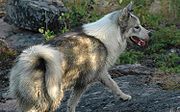 The coat is very thick and dense, with a soft undercoat and stiff, coarse guard hairs. The Eskimo Dog has a mane of thicker fur around its neck, which is quite impressive in the males and adds an illusion of additional size. This mane is smaller in females. Eskimo Dogs can be almost any colour, and no one colour or colour pattern should dominate. Solid white dogs are often seen, as well as white dogs with patches of another colour on the head or both body and head. Solid liver or black coloured dogs are common as well. Many of the solid coloured dogs have white mask-like markings on the face, sometimes with spots over the eyes. Others might have white socks and nose stripes with no eye spots or mask.
The coat is very thick and dense, with a soft undercoat and stiff, coarse guard hairs. The Eskimo Dog has a mane of thicker fur around its neck, which is quite impressive in the males and adds an illusion of additional size. This mane is smaller in females. Eskimo Dogs can be almost any colour, and no one colour or colour pattern should dominate. Solid white dogs are often seen, as well as white dogs with patches of another colour on the head or both body and head. Solid liver or black coloured dogs are common as well. Many of the solid coloured dogs have white mask-like markings on the face, sometimes with spots over the eyes. Others might have white socks and nose stripes with no eye spots or mask.
than some other breeds. Owing to their original environment, they take pure delight in cold weather, often preferring to sleep outside in cold climates. Like most spitz breeds they can be very vocal.
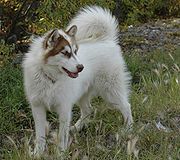 Canadian Eskimo Dogs need a very large amount of exercise. They cannot just be walked, they need higher intensity work, requiring more exercise than many dog owners can give. This need for work and stimulation also makes them well suited for dog sports, such as carting
Canadian Eskimo Dogs need a very large amount of exercise. They cannot just be walked, they need higher intensity work, requiring more exercise than many dog owners can give. This need for work and stimulation also makes them well suited for dog sports, such as carting
, mushing
, and skijoring
. They are very trainable and submissive, unlike many spitz breeds, as well as intelligent. The Canadian Eskimo Dog is best kept in a cold climate, and is prone to heatstroke. Its coat is fairly easy to care for most times of the year, needing brushing only one or two times a week. However when it sheds (which happens once a year) it will need grooming every day.
Historically, Inuit would put their dogs to the harness as soon as they could walk, and would acquire the habit of pulling sledges in their attempts to break free. At the age of two months, the pups would be placed with adult dogs. Sometimes, ten pups would be put under the lead of an older animal, coupled with frequent beatings from their masters, which would educate the pups.
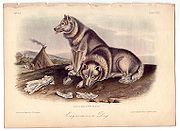
 The Canadian Eskimo Dog is known to have been resident in the Arctic for at least 4000 years. The Canadian Eskimo Dog was first bred by the Thule people
The Canadian Eskimo Dog is known to have been resident in the Arctic for at least 4000 years. The Canadian Eskimo Dog was first bred by the Thule people
, while research has shown that it is related to the Greenland dog
, with very little significant genetic differences. It is sometimes considered the same breed by authorities, although the Greenland dog
can be criticized for lacking any proper breeding program, questioning its validity as a pure breed
. Inuit never considered the dog as part of the animal kingdom (uumajuit), but merely as a tool for human existence. It was, and still is (to a very limited extent), used by the Canadian Inuit
as multi-purpose dogs, often put to work hunting seals
and other Arctic game, and hauling supplies and people. Explorers noted that the dogs were capable of tracking a seal hole from a great distance, and were occasionally used to hunt polar bear
s. The dogs were reported to be so enthusiastic in hunting bears that, sometimes, their handlers shouted "nennook" (their name for the bear) to encourage them when pulling sledges. The dogs however would not pursue wolves, and would howl fearfully at their approach. Frozen dog urine was used by Inuit as a medicine, and their fur was more prized than that of wolves, due to its greater resistance to wear. In times of famine
, the dogs would be used as an emergency food source
. Though once assumed to be a tamed wolf or wolf-dog hybrid by explorers, including Charles Darwin
due to similarities in appearance and vocalisations, genetic testing has shown that the Eskimo dog has no recent wolf ancestry.
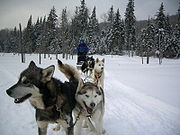 There is some debate surrounding the decline of the breed. Often the introduction of the snowmobile is cited as the main contributing factor. In the 19th century and early 20th century this breed was in demand for polar expeditions. When snowmobiles came into use, the population numbers started rapidly declining, because snowmobiles are faster and need less care. In the 1920s there were approximately 20,000 dogs living in the Canadian Arctic, and the breed had been accepted for showing
There is some debate surrounding the decline of the breed. Often the introduction of the snowmobile is cited as the main contributing factor. In the 19th century and early 20th century this breed was in demand for polar expeditions. When snowmobiles came into use, the population numbers started rapidly declining, because snowmobiles are faster and need less care. In the 1920s there were approximately 20,000 dogs living in the Canadian Arctic, and the breed had been accepted for showing
by both the AKC
and CKC
; however, in 1959 the AKC dropped the breed from its registry because of extremely low numbers. Inuit communities have gone on record for blaming the breed's decline on mass killings that occurred during the 1950s to 1970s. Many claim that the RCMP and other persons in authority killed Inuit sled dogs systematically and determinedly. It is proposed this was done to disrupt Inuit culture and way of life. Though there there is no major consensus, by 1963 there was supposedly only one dog registered with the CKC, and when this dog died there were still no others registered. The decline in dog population and allegations against the RCMP by Inuit is documented in the 2010 National Film Board of Canada
film Qimmit: A Clash of Two Truths.
, with some support from the CKC. The EDRF purchased dogs from the small (about 200 dogs) population remaining in the Canadian Arctic from remote Inuit camps on Baffin Island
, Boothia Peninsula
, and Melville Peninsula
. The EDRF then began breeding dogs in order to increase numbers.
The Canadian Eskimo Dog is still very rare; however, it is becoming more popular in Arctic tourism, with an increasing number of sled dog teams that entertain tourists. This new-found popularity is because tourists often enjoy seeing the dogs in their natural environment doing what they are meant for. On May 1, 2000, the Canadian territory of Nunavut
officially adopted the "Canadian Inuit Dog" as the animal symbol
of the territory, thus sealing the name of their traditional dog, qimmiq in the Inuktitut language
. This was recorded in the Hansard
01/05/2000 of the Legislative Assembly of the Nunavut Territory.
Arctic
The Arctic is a region located at the northern-most part of the Earth. The Arctic consists of the Arctic Ocean and parts of Canada, Russia, Greenland, the United States, Norway, Sweden, Finland, and Iceland. The Arctic region consists of a vast, ice-covered ocean, surrounded by treeless permafrost...
breed
Dog breed
Dog breeds are groups of closely related and visibly similar domestic dogs, which are all of the subspecies Canis lupus familiaris, having characteristic traits that are selected and maintained by humans, bred from a known foundation stock....
of dog
Dog
The domestic dog is a domesticated form of the gray wolf, a member of the Canidae family of the order Carnivora. The term is used for both feral and pet varieties. The dog may have been the first animal to be domesticated, and has been the most widely kept working, hunting, and companion animal in...
(Canis lupus familiaris), which is often considered to be North America
North America
North America is a continent wholly within the Northern Hemisphere and almost wholly within the Western Hemisphere. It is also considered a northern subcontinent of the Americas...
’s oldest and rarest
Rare breed (dog)
Rare breed is any breed of dog that is small in number. Since dogs have greater genetic variability than other domesticated animals the number of possible breeds is vast...
remaining purebred
Purebred
Purebreds, also called purebreeds, are cultivated varieties or cultivars of an animal species, achieved through the process of selective breeding...
indigenous domestic canine. Other names include Qimmiq (Inuit
Inuit language
The Inuit language is traditionally spoken across the North American Arctic and to some extent in the subarctic in Labrador. The related Yupik languages are spoken in western and southern Alaska and Russian Far East, particularly the Diomede Islands, but is severely endangered in Russia today and...
for "dog"). Although once used as the preferred method of transportation by Inuit in the Canadian Arctic, traditional working dog teams became increasingly rare in the North after the 1960s. This is often cited a result of snowmobile
Snowmobile
A snowmobile, also known in some places as a snowmachine, or sled,is a land vehicle for winter travel on snow. Designed to be operated on snow and ice, they require no road or trail. Design variations enable some machines to operate in deep snow or forests; most are used on open terrain, including...
s becoming more popular, however it may also be the result of the alleged organized and systematic mass slaughter of Inuit sled dogs in the Eastern Arctic between 1950 and 1970 by the Royal Canadian Mounted Police
Royal Canadian Mounted Police
The Royal Canadian Mounted Police , literally ‘Royal Gendarmerie of Canada’; colloquially known as The Mounties, and internally as ‘The Force’) is the national police force of Canada, and one of the most recognized of its kind in the world. It is unique in the world as a national, federal,...
.
Appearance
The Canadian Eskimo Dog should always be powerfully built, athletic, and imposing in appearance. It should be of "powerful physique giving the impression that he is not built for speed but rather for hard work." As is typical of spitzSpitz
Spitz-type dogs are a type of dog, characterized by long, thick, and often white fur, and pointed ears and muzzles...
breeds, it has erect, triangular ears, and a heavily feathered tail that is carried over its back. Males should be distinctly more masculine than females, who are finer boned, smaller, and often have a slightly shorter coat.
Its superficial similarity to wolves was often noted by explorers during the Coppermine Expedition of 1819–1822
Coppermine Expedition of 1819–1822
The Coppermine Expedition of 1819–1822 had as its goal the exploration of the northern coast of Canada, which was accessed by way of the Coppermine River. The British expedition was organised by the Royal Navy as part of its attempt to discover and map the Northwest Passage...
. They noted that the ears of the Eskimo dogs they encountered were similar to those of American wolves, and their forelegs lacked the black mark above the wrist characteristic of European wolves. The most sure way to distinguish the two species was said to be through the length and posture of the tail, which was shorter and more curved in the dog.
Coat and colour

Size
There is significant variance in size among Canadian Eskimo Dogs, and the weight and height should be proportionate to each other. The average size of Canadian Eskimo Dogs is:- Height (at the withersWithersThe withers is the ridge between the shoulder blades of a four-legged animal. In many species it is the tallest point of the body, and in horses and dogs it is the standard place to measure the animal's height .-Horses:The withers in horses are formed by the dorsal spinal processes of roughly the...
)- Males: 58 – 70 cm (23 – 28 in)
- Females: 50 – 60 cm (19½ - 23½ in)
- Weight
- Males: 30 - 40 kg (66 - 88 lb)
- Females: 18 – 30 kg (40 - 66 lb)
Temperament
The Canadian Eskimo Dog's temperament reflects its original work and environment. It is loyal, tough, brave, intelligent, and alert. It is affectionate and gentle, and develops a deep bond with its owner and is intensely loyal. When used as sled dogs, they were often required to forage and hunt for their own food. Consequently, many Canadian Eskimo Dogs have stronger prey drivePrey drive
Prey drive is the instinctive inclination of a carnivore to pursue and capture prey.In dog training, prey drive can be used as an advantage because dogs with strong prey drive are also willing to pursue moving objects such as toys, which can then be used to encourage certain kinds of behavior, such...
than some other breeds. Owing to their original environment, they take pure delight in cold weather, often preferring to sleep outside in cold climates. Like most spitz breeds they can be very vocal.
Care and training

Carting
Carting is a dog sport or activity in which a dog pulls a Dogcart filled with supplies, such as farm goods or firewood, but sometimes pulling people. Carting as a sport is also known as dryland mushing and is practiced all around the world, often to keep winter sled dogs in competition form during...
, mushing
Mushing
Mushing is a general term for a sport or transport method powered by dogs, and includes carting, pulka, scootering, sled dog racing, skijoring, freighting, and weight pulling. More specifically, it implies the use of one or more dogs to pull a sled on snow or a rig on dry land...
, and skijoring
Skijoring
Skijoring is a winter sport where a person on skis is pulled by a horse, a dog or a motor vehicle. It is derived from the Norwegian word skikjøring meaning ski driving.- Dog skijoring :...
. They are very trainable and submissive, unlike many spitz breeds, as well as intelligent. The Canadian Eskimo Dog is best kept in a cold climate, and is prone to heatstroke. Its coat is fairly easy to care for most times of the year, needing brushing only one or two times a week. However when it sheds (which happens once a year) it will need grooming every day.
Historically, Inuit would put their dogs to the harness as soon as they could walk, and would acquire the habit of pulling sledges in their attempts to break free. At the age of two months, the pups would be placed with adult dogs. Sometimes, ten pups would be put under the lead of an older animal, coupled with frequent beatings from their masters, which would educate the pups.
History


Thule people
The Thule or proto-Inuit were the ancestors of all modern Inuit. They developed in coastal Alaska by AD 1000 and expanded eastwards across Canada, reaching Greenland by the 13th century. In the process, they replaced people of the earlier Dorset culture that had previously inhabited the region...
, while research has shown that it is related to the Greenland dog
Greenland Dog
The Greenland Dog is a large breed of husky-type dog kept as a sled dog and for hunting polar bear and seal. This is an ancient breed, thought to be directly descended from dogs brought to Greenland by the first Inuit settlers.-Appearance:The Greenland Dog is a powerful, heavy-built dog...
, with very little significant genetic differences. It is sometimes considered the same breed by authorities, although the Greenland dog
Greenland Dog
The Greenland Dog is a large breed of husky-type dog kept as a sled dog and for hunting polar bear and seal. This is an ancient breed, thought to be directly descended from dogs brought to Greenland by the first Inuit settlers.-Appearance:The Greenland Dog is a powerful, heavy-built dog...
can be criticized for lacking any proper breeding program, questioning its validity as a pure breed
Purebred
Purebreds, also called purebreeds, are cultivated varieties or cultivars of an animal species, achieved through the process of selective breeding...
. Inuit never considered the dog as part of the animal kingdom (uumajuit), but merely as a tool for human existence. It was, and still is (to a very limited extent), used by the Canadian Inuit
Inuit
The Inuit are a group of culturally similar indigenous peoples inhabiting the Arctic regions of Canada , Denmark , Russia and the United States . Inuit means “the people” in the Inuktitut language...
as multi-purpose dogs, often put to work hunting seals
Pinniped
Pinnipeds or fin-footed mammals are a widely distributed and diverse group of semiaquatic marine mammals comprising the families Odobenidae , Otariidae , and Phocidae .-Overview: Pinnipeds are typically sleek-bodied and barrel-shaped...
and other Arctic game, and hauling supplies and people. Explorers noted that the dogs were capable of tracking a seal hole from a great distance, and were occasionally used to hunt polar bear
Polar Bear
The polar bear is a bear native largely within the Arctic Circle encompassing the Arctic Ocean, its surrounding seas and surrounding land masses. It is the world's largest land carnivore and also the largest bear, together with the omnivorous Kodiak Bear, which is approximately the same size...
s. The dogs were reported to be so enthusiastic in hunting bears that, sometimes, their handlers shouted "nennook" (their name for the bear) to encourage them when pulling sledges. The dogs however would not pursue wolves, and would howl fearfully at their approach. Frozen dog urine was used by Inuit as a medicine, and their fur was more prized than that of wolves, due to its greater resistance to wear. In times of famine
Famine
A famine is a widespread scarcity of food, caused by several factors including crop failure, overpopulation, or government policies. This phenomenon is usually accompanied or followed by regional malnutrition, starvation, epidemic, and increased mortality. Every continent in the world has...
, the dogs would be used as an emergency food source
Dog meat
Dog meat refers to edible parts and the flesh derived from dogs. Human consumption of dog meat has been recorded in many parts of the world, including ancient China, ancient Mexico, and ancient Rome. According to contemporary reports, dog meat is consumed in a variety of countries such as...
. Though once assumed to be a tamed wolf or wolf-dog hybrid by explorers, including Charles Darwin
Charles Darwin
Charles Robert Darwin FRS was an English naturalist. He established that all species of life have descended over time from common ancestry, and proposed the scientific theory that this branching pattern of evolution resulted from a process that he called natural selection.He published his theory...
due to similarities in appearance and vocalisations, genetic testing has shown that the Eskimo dog has no recent wolf ancestry.
Decline

Conformation show
Conformation shows, also referred to as breed shows, are a kind of dog show in which a judge familiar with a specific dog breed evaluates individual purebred dogs for how well the dogs conform to the established breed type for their breed, as described in a breed's individual breed standard.A...
by both the AKC
American Kennel Club
The American Kennel Club is a registry of purebred dog pedigrees in the United States. Beyond maintaining its pedigree registry, this kennel club also promotes and sanctions events for purebred dogs, including the Westminster Kennel Club Dog Show, an annual event which predates the official...
and CKC
Canadian Kennel Club
The Canadian Kennel Club is the primary registry body for purebred dog pedigrees in Canada. Beyond maintaining the pedigree registry, the C.K.C...
; however, in 1959 the AKC dropped the breed from its registry because of extremely low numbers. Inuit communities have gone on record for blaming the breed's decline on mass killings that occurred during the 1950s to 1970s. Many claim that the RCMP and other persons in authority killed Inuit sled dogs systematically and determinedly. It is proposed this was done to disrupt Inuit culture and way of life. Though there there is no major consensus, by 1963 there was supposedly only one dog registered with the CKC, and when this dog died there were still no others registered. The decline in dog population and allegations against the RCMP by Inuit is documented in the 2010 National Film Board of Canada
National Film Board of Canada
The National Film Board of Canada is Canada's twelve-time Academy Award-winning public film producer and distributor. An agency of the Government of Canada, the NFB produces and distributes documentary, animation, alternative drama and digital media productions...
film Qimmit: A Clash of Two Truths.
Resurgence
It probably would have gone extinct if not for the Eskimo Dog Research Foundation (EDRF). The EDRF was founded in 1972 by William Carpenter and John McGrath and was largely funded by the Canadian Government and the Northwest TerritoriesNorthwest Territories
The Northwest Territories is a federal territory of Canada.Located in northern Canada, the territory borders Canada's two other territories, Yukon to the west and Nunavut to the east, and three provinces: British Columbia to the southwest, and Alberta and Saskatchewan to the south...
, with some support from the CKC. The EDRF purchased dogs from the small (about 200 dogs) population remaining in the Canadian Arctic from remote Inuit camps on Baffin Island
Baffin Island
Baffin Island in the Canadian territory of Nunavut is the largest island in the Canadian Arctic Archipelago, the largest island in Canada and the fifth largest island in the world. Its area is and its population is about 11,000...
, Boothia Peninsula
Boothia Peninsula
Boothia Peninsula is a large peninsula in Nunavut's northern Canadian Arctic, south of Somerset Island. The northern part, Murchison Promontory, is the northernmost point of mainland Canada, and thus North America....
, and Melville Peninsula
Melville Peninsula
Melville Peninsula is a large peninsula in the Canadian Arctic. Since 1999, it has been part of Nunavut. Before that, it was part of the District of Franklin. It's separated from Southampton Island by Frozen Strait. The narrow isthmus connecting the peninsula to the mainland is styled the “Rae...
. The EDRF then began breeding dogs in order to increase numbers.
The Canadian Eskimo Dog is still very rare; however, it is becoming more popular in Arctic tourism, with an increasing number of sled dog teams that entertain tourists. This new-found popularity is because tourists often enjoy seeing the dogs in their natural environment doing what they are meant for. On May 1, 2000, the Canadian territory of Nunavut
Nunavut
Nunavut is the largest and newest federal territory of Canada; it was separated officially from the Northwest Territories on April 1, 1999, via the Nunavut Act and the Nunavut Land Claims Agreement Act, though the actual boundaries had been established in 1993...
officially adopted the "Canadian Inuit Dog" as the animal symbol
Symbols of Nunavut
Nunavut is one of Canada's territories, and has established several territorial symbols.-Symbols of nunavut:# "Qimmiq" or "qimmik" is the Inuit language word for "dog"...
of the territory, thus sealing the name of their traditional dog, qimmiq in the Inuktitut language
Inuktitut
Inuktitut or Eastern Canadian Inuktitut, Eastern Canadian Inuit language is the name of some of the Inuit languages spoken in Canada...
. This was recorded in the Hansard
Hansard
Hansard is the name of the printed transcripts of parliamentary debates in the Westminster system of government. It is named after Thomas Curson Hansard, an early printer and publisher of these transcripts.-Origins:...
01/05/2000 of the Legislative Assembly of the Nunavut Territory.

